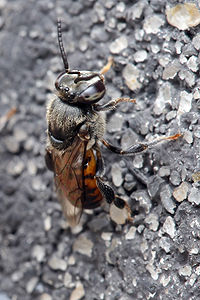
Photo from wikipedia
Our objective was to determine the timing of the highest parasitic activity by released Diachasmimorpha longicaudata (Ashmead) (Hymenoptera: Braconidae) in areas with fruits of sour orange and hog plums infested… Click to show full abstract
Our objective was to determine the timing of the highest parasitic activity by released Diachasmimorpha longicaudata (Ashmead) (Hymenoptera: Braconidae) in areas with fruits of sour orange and hog plums infested by Anastrepha ludens (Loew) and Anastrepha obliqua (McQuart) (Diptera: Tephritidae), under shaded and sunny conditions. Percent parasitism along fruit sampling period was related to host availability, which was influenced by the fruit size rather than environmental conditions. The highest parasitism in sour orange was obtained just the first day after release, but in hog plums this was observed during the first 3 days without significant differences between them. The levels of fruit infestation and parasitism were higher in shaded trees in sour orange as in hog plums. The high availability of larvae and the small size of hog plums were decisive for obtaining high levels of parasitism and keeping parasitoids near the release points. By contrast, the size and thick rind of sour orange provided to the larvae a physical refuge that was associated with lower parasitism, causing that parasitoids spread out in search of hosts more accessible. In sour orange, parasitism was exclusively by D. longicaudata, while in hog plums, we additionally found the coexistence of four native parasitoid species. This information suggests that in sour orange, the sampling should be performed 1 day after release, while in hog plums, the samplings can be extended to within the first 3 days. Such sampling can serve to better estimate the effect of D. longicaudata releases against Anastrepha pest populations in different fruit types.
Journal Title: Neotropical Entomology
Year Published: 2018
Link to full text (if available)
Share on Social Media: Sign Up to like & get
recommendations!